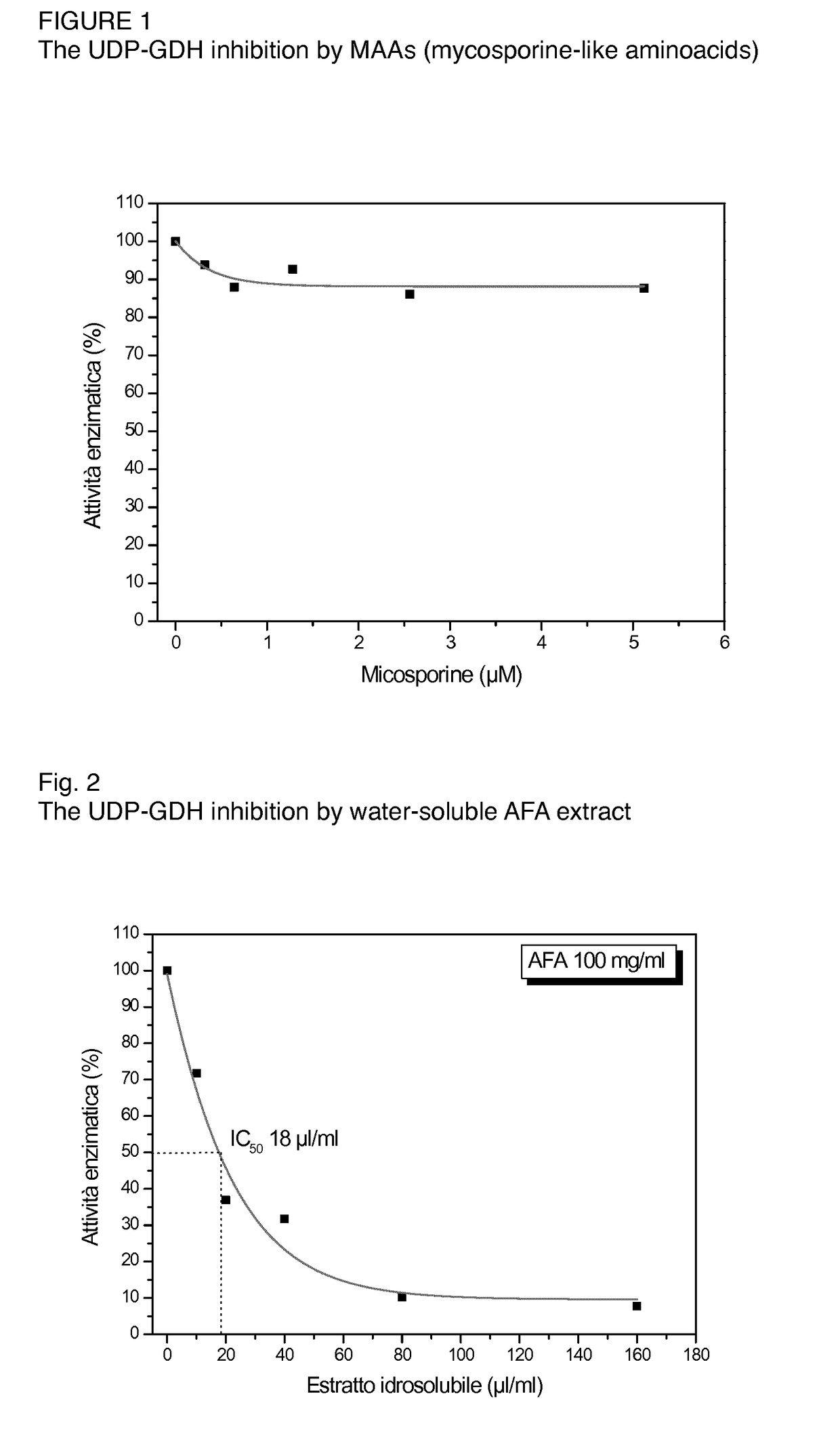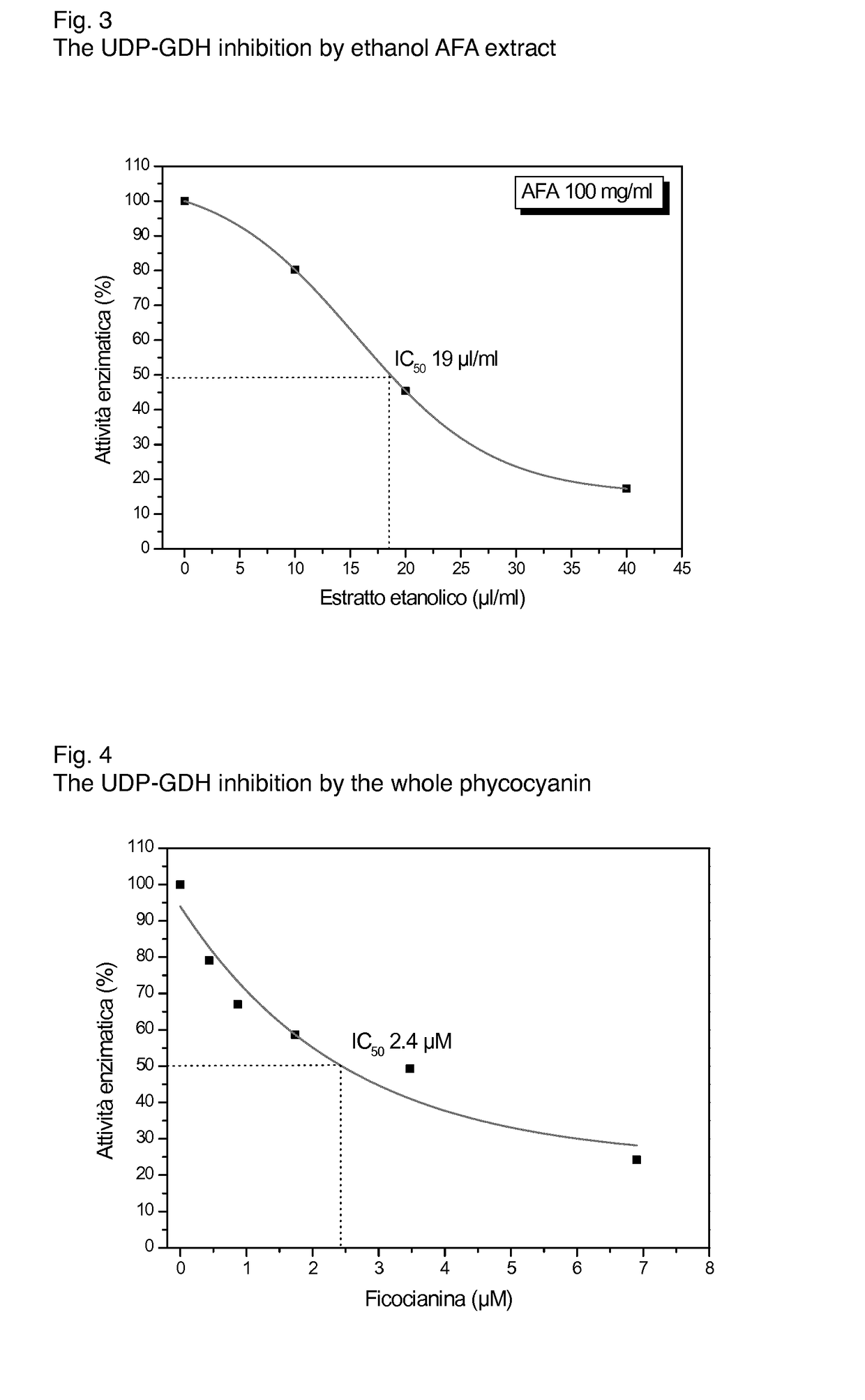Cyanobacterial microalgae phycocyanin and phycocyanobilin to beneficially inhibit the activity of the UDP-GDH enzyme while significantly increasing the absorption and circulation of curcumin
a technology of phycocyanin and phycocyanobilin, which is applied in the field of cyanobacterial microalgae phycocyanin and phycocyanobilin, can solve the problems of poor absorption and utilization, and achieve the effects of preventing glucuronidation, enhancing curcumin absorption, and enhancing curcumin absorption
- Summary
- Abstract
- Description
- Claims
- Application Information
AI Technical Summary
Benefits of technology
Problems solved by technology
Method used
Image
Examples
case 1
[0021]The subject number 1 had the following results: a) curcumin alone had a maximum plasma absorption of 64.8 ng / ml, with the peak being reached after approximately 1 hour after ingestion; b) the blend of curcumin+AFA had a maximum absorption of 426.8 ng / ml., which constitutes a 665% absolute increase (or 300% in terms of AUC), relative to curcumin alone; the absorption peak was reached at around 15 min. after ingestion; while the complete elimination of curcumin metabolites from plasma was achieved at around 30 min. after ingestion (see FIG. 10). Adjusting for the 50% less curcumin used, we can approximately establish an absolute increase of approx. 1000% (10-fold) and of 450% in terms of AUC.
case 2
[0022]The subject number 2 had the following results: a) curcumin alone had a maximum plasma absorption of 76 ng / ml, with the peak being reached after approximately 15 min. after ingestion; b) the blend of curcumin+AFA had a maximum absorption of 377 ng / ml., which constitutes a 228% increase (in terms of standard curve—almost 500% in absolute terms), relative to curcumin alone; the absorption peak was reached at around 30 min. after ingestion; while the complete elimination of curcumin metabolites from the plasma was achieved at around 60 min. after ingestion (FIG. 11). Adjusting for the 50% less curcumin used, we can approximately establish an absolute absorption increase of approx. 750%, and of 340% in terms of AUC.
case 3
[0023]The subject number 3 had the following results: a) curcumin alone had a maximum plasma absorption below weight quantity detection; b) the blend of curcumin+AFA had a maximum absorption of 7.7 ng / ml., which constitutes a 140% increase relative to curcumin alone (the absolute comparison is not possible here for lack of weight quantification of curcumin alone); the absorption peak was reached at around 30 min. after ingestion; while the elimination of the major percentage of curcumin metabolites from the plasma was achieved at around 60 min. after ingestion, with a further slow reduction in the 2nd hour (FIG. 12). Adjusting for the 50% less curcumin used in the mix formula, we can approximately establish an increase of approx. 220% in terms of AUC.
B) Curcumin+AFA PC Concentrate
PUM
| Property | Measurement | Unit |
|---|---|---|
| antioxidant | aaaaa | aaaaa |
| concentration | aaaaa | aaaaa |
| stress | aaaaa | aaaaa |
Abstract
Description
Claims
Application Information
 Login to View More
Login to View More - R&D
- Intellectual Property
- Life Sciences
- Materials
- Tech Scout
- Unparalleled Data Quality
- Higher Quality Content
- 60% Fewer Hallucinations
Browse by: Latest US Patents, China's latest patents, Technical Efficacy Thesaurus, Application Domain, Technology Topic, Popular Technical Reports.
© 2025 PatSnap. All rights reserved.Legal|Privacy policy|Modern Slavery Act Transparency Statement|Sitemap|About US| Contact US: help@patsnap.com



